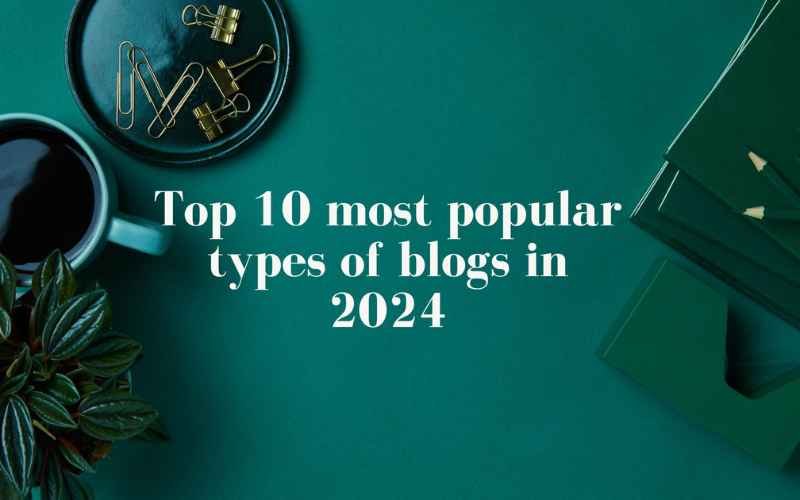In 2024, blogging continues to evolve with new trends and interests shaping the online landscape. Whether you’re a seasoned blogger or just starting out, understanding the most popular types of blogs can inspire your next venture into the digital world.

1. Personal Development Blogs:
Personal development blogs serve as digital platforms dedicated to enhancing various aspects of individuals’ lives. They typically focus on self-improvement, offering insights into personal growth, productivity strategies, and life coaching advice. Here’s a breakdown of their key components:
- Self-Improvement: These blogs often provide practical advice and techniques to help individuals enhance their skills, develop positive habits, and overcome challenges. Topics may include time management, goal setting, decision-making, and fostering resilience.
- Productivity Tips: Effective time management and productivity enhancement techniques are commonly featured. This may include methods for prioritizing tasks, optimizing workflow, and maintaining focus amidst distractions.
- Life Coaching: Many blogs offer life coaching insights, addressing personal development challenges such as improving confidence, managing stress, cultivating mindfulness, and fostering healthier relationships.
- Inspiration and Motivation: Personal development blogs aim to inspire readers through success stories, motivational quotes, and uplifting content. They encourage individuals to pursue their ambitions, stay motivated during setbacks, and maintain a positive mindset.
- Goal Achievement: They often emphasize goal-setting strategies, breaking down long-term objectives into manageable steps, and providing tools for tracking progress and staying accountable.
- Holistic Approach: Some blogs adopt a holistic approach, integrating physical, mental, emotional, and spiritual well-being into their advice. This can include fitness tips, nutrition advice, mindfulness practices, and strategies for achieving work-life balance.
Overall, personal development blogs serve as valuable resources for individuals seeking guidance on achieving personal and professional fulfillment. They empower readers to take proactive steps towards self-improvement, enabling them to lead more meaningful and productive lives.
2. Health and Wellness Blogs:
Health and wellness blogs are online platforms that focus on promoting physical, mental, and emotional well-being. They provide valuable information, tips, and resources aimed at improving overall health and quality of life. Here are the key aspects typically covered in health and wellness blogs:
- Fitness Routines: These blogs offer workout plans, exercise tips, and routines designed to enhance strength, flexibility, cardiovascular health, and overall fitness levels. They may cater to different fitness levels and goals, from beginners to advanced athletes.
- Healthy Recipes and Nutrition: Nutrition is a cornerstone of health blogs, featuring nutritious recipes, dietary tips, meal planning ideas, and information on wholesome eating habits. They often emphasize balanced diets, superfoods, and strategies for managing weight and boosting energy.
- Mental Health Awareness: Many health and wellness blogs address mental health issues such as stress management, anxiety relief, mindfulness practices, and techniques for enhancing emotional resilience. They may provide resources for seeking professional help and support.
- Holistic Lifestyles: Emphasizing a holistic approach to well-being, these blogs explore alternative therapies, natural remedies, and practices like yoga, meditation, and aromatherapy. They promote a balanced lifestyle that integrates physical, mental, and spiritual health.
- Wellness Trends and Research: Blogs often discuss emerging trends in health and wellness, such as new fitness techniques, dietary supplements, health gadgets, and research-backed findings in the field of wellness.
- Personal Stories and Inspiration: Health and wellness blogs may feature personal stories of individuals overcoming health challenges, achieving fitness goals, or adopting healthier lifestyles. These stories serve to inspire readers and provide relatable experiences.
- Community and Support: Some blogs foster a sense of community among their readers, offering forums, support groups, and opportunities for interaction. This can create a supportive environment for sharing experiences, tips, and encouragement.
Overall, health and wellness blogs play a crucial role in educating, motivating, and empowering individuals to make informed choices about their health. They serve as comprehensive resources for adopting healthier habits, enhancing overall well-being, and living a balanced, fulfilling life.
3. Technology and Gadgets Reviews:
Technology and gadgets reviews blogs are dedicated platforms that cater to tech enthusiasts, consumers, and professionals alike. They provide comprehensive coverage of various aspects of technology, including:
- Gadget Reviews: These blogs offer in-depth reviews and analyses of the latest gadgets, including smartphones, laptops, tablets, wearable devices, smart home technology, and more. Reviews often include hands-on experiences, performance tests, comparisons with similar products, and recommendations for different user needs.
- Tech News Updates: They keep readers informed about the latest developments in the tech industry, including product launches, updates from tech giants like Apple, Google, Microsoft, and others, mergers and acquisitions, industry trends, and regulatory changes.
- Tutorials and How-To Guides: Tech blogs provide practical tutorials and guides on how to use new technology effectively. This may include setting up devices, troubleshooting common issues, optimizing performance, and exploring advanced features.
- Opinion Pieces and Analysis: Bloggers often share their insights and opinions on tech-related topics, offering critical analyses of industry trends, emerging technologies (such as AI, blockchain, IoT), and their potential impact on society, business, and daily life.
- Buying Guides and Recommendations: Many tech blogs publish buying guides to help consumers make informed decisions when purchasing gadgets. These guides may highlight the best products in different categories, considering factors like performance, price, design, and user reviews.
- Interviews and Expert Insights: Some blogs feature interviews with tech industry leaders, innovators, and experts, providing insider perspectives on future tech trends, research developments, and entrepreneurial journeys.
- Community Interaction: Tech blogs often foster a community of tech enthusiasts through comments sections, forums, and social media engagement. This allows readers to share their opinions, ask questions, and exchange knowledge with like-minded individuals.
Overall, technology and gadgets reviews blogs serve as valuable resources for staying updated on the latest tech innovations, making informed purchasing decisions, learning how to maximize the utility of new gadgets, and exploring the broader impact of technology on society and everyday life.
4. Travel Blogs:
Travel blogs are popular online platforms that cater to individuals passionate about exploring new destinations, seeking adventure, and experiencing diverse cultures. Here are the key features and content typically found in travel blogs:
- Personal Experiences: Travel bloggers share their personal adventures and journeys, recounting their experiences, discoveries, and memorable moments from trips around the world. These narratives often provide a firsthand perspective on different destinations and activities.
- Destination Guides: Blogs offer comprehensive guides to various travel destinations, including popular tourist spots, off-the-beaten-path locations, cities, countries, and regions. These guides typically cover attractions, landmarks, local cuisine, cultural insights, and practical tips for travelers.
- Travel Tips and Advice: Travel blogs provide practical tips and advice for planning trips, such as budgeting, packing essentials, visa requirements, transportation options, accommodation reviews, and safety considerations. They aim to help readers navigate their travel experiences smoothly and efficiently.
- Photography and Visual Content: Visual storytelling is a hallmark of travel blogs, featuring stunning photography, travel videos, and multimedia content that capture the beauty and essence of destinations. High-quality images help readers visualize the places described and inspire wanderlust.
- Adventure and Outdoor Activities: Many travel blogs focus on adventure travel, showcasing activities such as hiking, trekking, water sports, wildlife safaris, skiing, and other adrenaline-pumping experiences. They provide insights into adventurous pursuits and tips for enthusiasts.
- Cultural Exploration: Blogs delve into cultural experiences, traditions, festivals, and local customs encountered during travels. They highlight the diversity of cultures worldwide, fostering appreciation and understanding among readers.
- Solo and Group Travel: Travel bloggers often share insights into solo travel adventures, safety tips, and the benefits of exploring alone. They also discuss group travel dynamics, including tips for traveling with friends, family, or organized tours.
- Sustainability and Responsible Travel: Many travel blogs emphasize sustainable travel practices, eco-friendly tourism initiatives, and responsible travel tips to minimize environmental impact and support local communities.
- Travel Inspiration and Stories: Beyond practical advice, travel blogs inspire readers with inspiring stories, travel bucket lists, dream destinations, and personal reflections on the transformative power of travel.
- Community Engagement: Blogs foster a community of travel enthusiasts through comments sections, social media interactions, and travel forums. This allows readers to share their own travel experiences, seek recommendations, and connect with like-minded individuals.
Overall, travel blogs serve as valuable resources for both armchair travelers seeking inspiration and practical advice, as well as active travelers looking to plan their next adventure. They celebrate the joy of exploration, cultural immersion, and the beauty of our world’s diverse landscapes and communities.
5. Fashion and Lifestyle Blogs:
Fashion and lifestyle blogs are vibrant online platforms that cater to fashion enthusiasts, trend followers, and individuals interested in personal style and living. Here are the key elements and content typically featured in fashion and lifestyle blogs:
- Fashion Trends and Style Inspiration: Blogs offer updates on the latest fashion trends, seasonal collections, and runway looks from major fashion weeks around the world. They provide style inspiration through outfit ideas, styling tips, and wardrobe essentials for various occasions.
- Beauty Tips and Makeup Tutorials: Many blogs cover beauty trends, skincare routines, makeup tutorials, and product reviews. They offer tips on achieving different looks, using makeup techniques, and maintaining skincare routines for healthy skin.
- Fashion Photography and Visual Content: Visual aesthetics are crucial in fashion blogs, showcasing high-quality photography, fashion editorials, lookbooks, and street style photos. Visual content enhances the appeal of fashion narratives and highlights fashion statements.
- Personal Style and Fashion Diaries: Bloggers share their personal style journeys, showcasing their individual fashion sense, wardrobe staples, and fashion choices. They often document their daily outfits, fashion hauls, and style evolution over time.
- Shopping Guides and Product Recommendations: Blogs provide curated shopping guides, featuring fashion items, accessories, beauty products, and lifestyle gadgets. They offer recommendations based on quality, style, affordability, and current trends.
- Fashion Events and Industry Insights: Bloggers cover fashion events, collaborations, designer interviews, and industry news. They discuss the business side of fashion, including brand partnerships, influencer collaborations, and emerging designers.
- Lifestyle Content: Beyond fashion, lifestyle blogs often include content on travel, wellness, home decor, fitness routines, entertainment, and cultural experiences. They provide a holistic view of modern living and lifestyle choices.
- Social Media and Influencer Culture: Many fashion bloggers leverage social media platforms like Instagram, YouTube, and Pinterest to engage with their audience, share visual content, and collaborate with brands. They influence trends and consumer behavior through their online presence.
- Diversity and Inclusivity: There is a growing emphasis on diversity in fashion and lifestyle blogs, celebrating different body types, cultural backgrounds, and personal identities. Bloggers promote inclusivity through their content and collaborations.
- Community Engagement: Fashion and lifestyle blogs foster a community of followers, fashion enthusiasts, and aspiring influencers. They encourage interaction through comments, social media shares, and reader feedback, creating a supportive and interactive online community.
Overall, fashion and lifestyle blogs serve as dynamic platforms for creativity, self-expression, and trendsetting within the fashion industry. They inspire readers to explore their personal style, experiment with trends, and embrace the intersection of fashion, beauty, and lifestyle choices.
6. Food and Recipe Blogs:
Food and recipe blogs are popular among food lovers, home cooks, and culinary enthusiasts seeking inspiration, recipes, and culinary knowledge. Here are the key elements and content typically found in food and recipe blogs:
- Recipes: The core of food blogs is their collection of recipes spanning various cuisines, dietary preferences (like vegan, gluten-free, etc.), and meal types (breakfast, lunch, dinner, desserts). Recipes are often accompanied by step-by-step instructions, ingredient lists, cooking tips, and serving suggestions.
- Culinary Tips and Techniques: Blogs offer culinary advice, cooking techniques, kitchen hacks, and tips for mastering specific cooking methods (such as baking, grilling, stir-frying, etc.). They may also cover ingredient substitutions, cooking equipment recommendations, and troubleshooting common cooking issues.
- Food Photography and Visual Appeal: Visual storytelling is crucial in food blogs, with mouth-watering food photography, food styling tips, and presentation ideas enhancing the appeal of recipes. High-quality images capture the textures, colors, and details of dishes, enticing readers to try the recipes.
- Seasonal and Holiday Recipes: Blogs feature seasonal recipes that highlight fresh produce and ingredients available during specific times of the year. They also provide holiday-themed recipes for festive occasions like Christmas, Thanksgiving, Eid, Diwali, and more.
- Restaurant Reviews and Food Destinations: Some food blogs include restaurant reviews, dining experiences, food tours, and recommendations for foodie destinations. Bloggers share their culinary adventures, exploring local eateries, food markets, and hidden gems.
- Healthy Eating and Nutrition: Many food blogs focus on healthy eating, offering nutritious recipes, diet-friendly options, meal planning ideas, and insights into balanced eating habits. They may cover topics like superfoods, meal prepping, and wellness-oriented cooking.
- Global Cuisine and Cultural Insights: Blogs celebrate diverse cuisines from around the world, featuring recipes inspired by international dishes, regional specialties, and cultural culinary traditions. They provide insights into culinary heritage, ingredients, and cooking methods unique to different cultures.
- Cookbook Reviews and Author Interviews: Some blogs review cookbooks, share cookbook recommendations, and interview cookbook authors. They highlight new releases, classic favorites, and cookbooks catering to specific interests or dietary needs.
- DIY Projects and Food Crafts: Beyond recipes, food blogs may include DIY projects like homemade pantry staples, food preservation techniques (like canning or fermenting), and creative food crafts (like edible gifts or food art).
- Community Engagement: Food blogs foster a community of food enthusiasts through comments sections, social media interactions, recipe sharing, and culinary discussions. Readers often engage with bloggers, share their cooking experiences, and seek advice from fellow food lovers.
Overall, food and recipe blogs serve as valuable resources for discovering new flavors, expanding culinary skills, exploring global cuisines, and celebrating the joy of cooking and sharing meals with others. They inspire creativity in the kitchen and connect food enthusiasts worldwide through a shared passion for good food.
7. Finance and Investment Blogs:
Finance and investment blogs are valuable resources for individuals seeking to enhance their financial knowledge, manage their money effectively, and make informed investment decisions. Here are the key elements and content typically found in finance and investment blogs:
- Budgeting and Financial Planning: Blogs provide guidance on creating budgets, managing expenses, saving money, and setting financial goals. They offer practical tips for budgeting techniques, expense tracking, and developing a savings plan.
- Investment Strategies: Blogs discuss various investment options, such as stocks, bonds, mutual funds, ETFs (Exchange-Traded Funds), real estate, and retirement accounts (like 401(k) or IRA). They analyze investment strategies, portfolio diversification, risk management, and long-term wealth accumulation.
- Financial Literacy and Education: Blogs focus on improving financial literacy, educating readers on basic financial concepts, terminology, and principles of personal finance. They aim to empower readers with the knowledge to make sound financial decisions.
- Market Trends and Analysis: Finance blogs provide updates on economic trends, market developments, and financial news. They analyze market conditions, geopolitical factors, and their potential impact on investments and personal finances.
- Retirement Planning: Blogs offer guidance on retirement planning strategies, including estimating retirement needs, choosing retirement accounts, maximizing Social Security benefits, and planning for a financially secure retirement.
- Taxation and Tax Planning: Many blogs cover tax-saving strategies, deductions, credits, and tax-efficient investment strategies. They provide insights into tax laws, filing tips, and maximizing tax benefits to minimize tax liabilities.
- Personal Finance Tips: Blogs offer practical advice on managing debt, improving credit scores, understanding insurance options (like life insurance, health insurance), and navigating financial challenges (such as job changes or unexpected expenses).
- Entrepreneurship and Side Hustles: Some finance blogs explore entrepreneurship, starting a business, freelancing, and generating additional income streams through side hustles. They discuss financial aspects of entrepreneurship, business planning, and financial risks and rewards.
- Investment Reviews and Recommendations: Blogs review investment platforms, financial products, robo-advisors, and tools for managing investments. They offer unbiased reviews, comparisons, and recommendations based on performance, fees, and user experience.
- Personal Finance Success Stories: Blogs may feature success stories of individuals who have achieved financial independence, overcome financial challenges, or implemented successful investment strategies. These stories inspire and motivate readers on their financial journeys.
Overall, finance and investment blogs serve as educational platforms, offering valuable insights, practical advice, and expert perspectives to help readers achieve financial stability, build wealth, and plan for a secure financial future. They empower individuals to take control of their finances, make informed decisions, and navigate the complexities of the financial world effectively.
8. DIY and Crafts Blogs:
DIY and crafts blogs are creative hubs that inspire and guide enthusiasts in various crafting endeavors, home decor projects, and handmade creations. Here are the key elements and content typically found in DIY and crafts blogs:
- Crafting Tutorials: Blogs offer step-by-step tutorials and instructions for various crafts such as knitting, crocheting, sewing, painting, woodworking, jewelry making, and paper crafts. They cater to beginners as well as advanced crafters looking to learn new techniques.
- Home Decor Projects: Blogs feature DIY home decor ideas and projects for decorating interiors and exteriors. This may include furniture makeovers, wall art, decorative accents, seasonal decorations, and room transformations on a budget.
- Upcycling and Recycling: Many blogs focus on upcycling and repurposing old or unused items into new and useful creations. They provide ideas for transforming thrifted finds, recycling materials, and reducing waste through creative projects.
- Handmade Gifts and Personalized Creations: Blogs showcase DIY gift ideas for various occasions such as birthdays, weddings, holidays, and special events. They include handmade cards, personalized gifts, DIY gift baskets, and thoughtful crafts that show creativity and personal touch.
- Craft Supplies and Tools: Blogs review and recommend essential craft supplies, tools, materials, and equipment needed for different types of crafts. They provide tips on where to buy supplies, how to organize craft spaces, and storage solutions.
- Seasonal and Holiday Crafts: Blogs feature seasonal and holiday-themed crafts and decorations for celebrations like Christmas, Halloween, Easter, Valentine’s Day, and more. They inspire readers to create festive decor, handmade ornaments, and themed crafts.
- Crafting Techniques and Skills: Blogs offer articles and resources on improving crafting skills, mastering specific techniques (e.g., knitting stitches, painting techniques, woodworking joinery), and troubleshooting common crafting challenges.
- Creative Inspiration and Ideas: Blogs provide inspiration boards, mood boards, and creative prompts to spark ideas for new projects. They showcase trending crafts, innovative designs, and artistic inspirations from around the world.
- Community and Collaboration: DIY and crafts blogs foster a community of craft enthusiasts through comments sections, social media interactions, and online forums. They encourage readers to share their creations, ask questions, and collaborate on crafting projects.
- Crafting Events and Workshops: Some blogs announce crafting events, workshops, craft fairs, and community gatherings where readers can participate, learn new skills, and connect with fellow crafters offline.
Overall, DIY and crafts blogs serve as creative resources for exploring hobbies, expressing creativity, and transforming everyday materials into unique handmade creations. They celebrate the joy of crafting, encourage experimentation, and empower readers to personalize their spaces and gifts with homemade charm.
9. Parenting and Family Blogs:
Parenting and family blogs serve as valuable resources for parents, caregivers, and families navigating the joys and challenges of raising children. Here are the key elements and content typically found in parenting and family blogs:
- Parenting Tips and Advice: Blogs offer practical tips and advice on various aspects of parenting, including newborn care, toddler parenting, discipline techniques, positive parenting strategies, and navigating different stages of childhood and adolescence.
- Child Development and Education: Blogs provide insights into child development milestones, educational resources, learning activities, and age-appropriate toys and games. They offer guidance on supporting children’s cognitive, emotional, and social growth.
- Family Activities and Bonding: Blogs suggest family-friendly activities, outings, and experiences that promote bonding and create lasting memories. This may include DIY projects, outdoor adventures, travel tips with kids, and ideas for celebrating holidays and special occasions.
- Health and Wellness: Many blogs cover children’s health topics, wellness tips, nutrition advice, and promoting healthy lifestyles for the whole family. They discuss common health concerns, vaccination schedules, mental health awareness, and fostering physical well-being.
- Parenting Challenges and Solutions: Blogs address common parenting challenges such as sleep issues, sibling rivalry, managing screen time, handling tantrums, and balancing work-life responsibilities. They offer practical solutions and parenting hacks shared from personal experiences.
- Special Needs and Parenting Resources: Some blogs focus on parenting children with special needs or disabilities, providing support, resources, and advocacy tips. They discuss inclusive parenting practices, accessing therapies, and navigating educational support systems.
- Parenting Styles and Philosophy: Blogs explore different parenting styles (e.g., authoritative, permissive, attachment parenting) and philosophies (e.g., Montessori, Waldorf) to help parents find approaches that align with their values and goals.
- Product Reviews and Recommendations: Blogs review parenting products, baby gear, children’s books, educational toys, tech gadgets for families, and household essentials. They offer insights into quality, safety, usability, and value for money.
- Family Finance and Budgeting: Some blogs discuss financial planning for families, budgeting tips, saving for college, managing expenses related to childcare and extracurricular activities, and teaching children about money management.
- Community and Support: Parenting blogs foster a supportive community of parents and caregivers through comments sections, social media engagement, and online forums. They encourage sharing experiences, seeking advice, and connecting with others facing similar parenting journeys.
Overall, parenting and family blogs play a vital role in providing encouragement, resources, and a sense of community for parents navigating the rewarding and complex role of raising children. They empower parents to make informed decisions, prioritize family well-being, and cherish the moments of parenthood.
10. Gaming and Entertainment Blogs:
Gaming and entertainment blogs are popular online destinations for enthusiasts seeking updates, reviews, and insights into the world of gaming, movies, TV shows, and pop culture. Here are the key elements and content typically found in gaming and entertainment blogs:
- Video Game Reviews and Previews: Blogs offer detailed reviews and previews of video games across different platforms (PC, console, mobile). They analyze gameplay mechanics, graphics, storyline, replay value, and provide recommendations for gamers of varying preferences.
- eSports and Gaming Tournaments: Many blogs cover eSports news, including tournament schedules, results, player profiles, and analysis of competitive gaming scenes (e.g., League of Legends, Dota 2, CS). They discuss eSports events, team dynamics, and emerging trends in professional gaming.
- Gameplay Tips and Strategies: Blogs provide gameplay tips, tutorials, and strategy guides to help players improve their skills and navigate challenging levels or multiplayer modes. They may feature walkthroughs, cheat codes, and updates on game patches or expansions.
- Movie and TV Show Reviews: Blogs review movies, TV shows, and streaming content, offering critiques, ratings, and recommendations. They discuss plot summaries, cinematography, performances, and the overall entertainment value of films and series.
- Pop Culture Trends and Analysis: Blogs explore current pop culture trends, memes, viral content, and social media sensations. They cover fandoms, fan theories, celebrity news, and events shaping entertainment and internet culture.
- Entertainment Industry News: Blogs provide updates on entertainment industry news, including film releases, casting announcements, box office performance, studio mergers, and developments in the music industry.
- Celebrity Interviews and Profiles: Some blogs feature interviews with celebrities, directors, game developers, and influencers within the entertainment industry. They offer insights into creative processes, career milestones, and behind-the-scenes stories.
- Fan Community Engagement: Gaming and entertainment blogs foster engagement with fan communities through comments sections, forums, and social media interactions. They encourage discussions, fan theories, and sharing of fan art or creative content.
- Tech and Gaming Gadgets: Blogs review gaming hardware, accessories, VR (Virtual Reality), and AR (Augmented Reality) devices, offering recommendations for gaming rigs, consoles, controllers, and gaming peripherals.
- Event Coverage and Conventions: Some blogs cover major gaming conventions (e.g., E3, Gamescom), comic-cons, and entertainment expos. They provide event highlights, panel discussions, cosplay showcases, and exclusive interviews from the show floor.
Overall, gaming and entertainment blogs serve as dynamic platforms for enthusiasts to stay informed, discover new content, engage with community discussions, and celebrate their passion for gaming, movies, TV shows, and pop culture. They cater to diverse interests within the entertainment landscape, offering a mix of informative content, entertainment reviews, and interactive engagement with readers and fans.
Conclusion:
As blogging continues to evolve, these top 10 popular types of blogs in 2024 reflect diverse interests and passions. Whether you’re passionate about health, technology, travel, or food, there’s a niche waiting for your unique voice in the blogging world.
FAQs
- What is a blog? A blog is a regularly updated website or web page, typically run by an individual or small group, that is written in an informal or conversational style. Blogs often focus on specific topics or niches and allow readers to engage through comments.
- How do I start a blog? Starting a blog involves choosing a niche, selecting a blogging platform (like WordPress or Blogger), registering a domain name, choosing a hosting provider, designing your blog, and creating content that resonates with your audience.
- Can I make money from blogging? Yes, many bloggers monetize their blogs through various methods such as affiliate marketing, sponsored posts, selling digital products or services, offering online courses, and displaying ads through platforms like Google AdSense.
- What are the benefits of blogging? Blogging can help establish authority in a niche, improve writing and communication skills, build a community of like-minded individuals, generate passive income, and provide a platform to share knowledge and expertise.
- How often should I publish new blog posts? The frequency of blog posts depends on your niche and audience engagement. Generally, consistency is key; aim for at least one high-quality post per week to maintain reader interest and improve SEO.
- What makes a blog post successful? Successful blog posts are well-written, informative, and engaging. They address a specific audience’s needs or interests, use SEO best practices to attract organic traffic, and encourage reader interaction through comments and social shares.
- Do I need to be a good writer to start a blog? While strong writing skills are beneficial, you don’t need to be a professional writer to start a blog. Authenticity, passion for your topic, and a willingness to improve over time are more important than perfect grammar.
- How can I promote my blog? Promote your blog through social media platforms, email newsletters, guest posting on other blogs, participating in online communities and forums, SEO optimization, and networking with influencers in your niche.
- What are SEO and why is it important for my blog? SEO (Search Engine Optimization) involves optimizing your blog content and website to rank higher in search engine results pages (SERPs). Good SEO practices increase organic traffic, visibility, and reach for your blog.
- How do I choose a niche for my blog? Choose a niche based on your interests, expertise, and audience demand. Research potential topics, evaluate competition, and consider your long-term commitment and passion for the subject matter.
- Is it too late to start a blog in 2024? No, it’s never too late to start a blog. The internet continues to grow, and there are always new audiences and niches emerging. Focus on unique content, quality, and connecting with your target audience.
- What are the legal considerations for blogging? Legal considerations for blogging include copyright laws (using images and content legally), disclosure of sponsored content, privacy policies, and adhering to advertising regulations in your country or region.
- How can I grow my blog’s audience? To grow your blog’s audience, create valuable content consistently, engage with your readers through comments and social media, collaborate with influencers, optimize for SEO, and use analytics to understand your audience’s preferences.
- What are the common mistakes new bloggers make? Common mistakes include inconsistency in posting, neglecting SEO practices, not engaging with readers, focusing solely on monetization instead of building content quality, and not networking with other bloggers.
- Should I use free blogging platforms or self-hosted platforms? Free platforms like WordPress.com or Blogger are suitable for beginners, but self-hosted platforms (using WordPress.org with a hosting provider) offer more flexibility, customization options, and control over your blog’s future.
- How can I come up with blog post ideas? Generate blog post ideas by researching trending topics in your niche, conducting keyword research, asking your audience for feedback or questions, reviewing competitor content, and addressing common pain points or challenges.
- What are the best tools for blogging? Essential tools for blogging include content management systems (CMS) like WordPress, SEO tools (e.g., Yoast SEO), email marketing platforms (e.g., Mailchimp), graphic design tools (e.g., Canva), and analytics tools (e.g., Google Analytics).
- How do I deal with writer’s block as a blogger? Overcome writer’s block by taking breaks, engaging in activities that inspire creativity, brainstorming ideas, creating an editorial calendar, exploring different formats (e.g., lists, tutorials, interviews), and seeking feedback from peers or mentors.
- How long should my blog posts be? Blog post length varies depending on your niche and content type. Aim for a minimum of 800 words to provide valuable information, but don’t hesitate to write longer posts (1500+ words) for in-depth guides or comprehensive content.
- How do I measure the success of my blog? Measure blog success through metrics like traffic (unique visitors, page views), engagement (comments, social shares), conversion rates (newsletter sign-ups, sales), SEO rankings, and achieving goals set in your blogging strategy.















